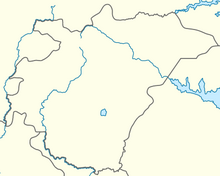Obuasi Gold Mine
| Location | |
|---|---|
 Obuasi Gold Mine Location in Ashanti | |
| Location | Obuasi |
| Municipality | |
| Country | |
| Coordinates | 06°08′53″N 01°41′30″W / 6.14806°N 1.69167°WCoordinates: 06°08′53″N 01°41′30″W / 6.14806°N 1.69167°W |
| Production | |
| Products | Gold |
| Production | 160,000 ounces |
| Financial year | 2020 |
| Type | Underground |
| Owner | |
| Company | AngloGold Ashanti |
| Website | AngloGold Ashanti website |
| Year of acquisition | 2004 |
The Obuasi Gold Mine is an underground gold mine situated near Obuasi, in the Ashanti Region of Ghana. It was one of the top-10 largest gold mines on Earth.[1] The mine is in Obuasi Municipal District, 39 miles (59.4 kilometers) south-west of regional capital Kumasi.[2]
In 2008, AngloGold Ashanti's Ashantiland operations, consisting of Obuasi and the Iduapriem Gold Mine, contributed 11% to the company's annual production.
History[]
There is a long history of mining in the area, with gold mining from the Ashanti region providing the gold for which the Gold Coast got its name. Large scale commercial and industrial mining began at Obuasi, in 1897 with the formation of the Ashanti Goldfields Corporation.[3]
In 2004, Ashanti Goldfields merged with AngloGold to form AngloGold Ashanti. Following heavy losses mining was suspended in late 2014 with about 5,000 employees being laid off and the mine put into Care and Maintenance. During this time a large security force remained on site due to heavy pressure from local illegal miners. In 2016 an Obuasi employee was killed by a mob of illegal miners. [4][5]
In 2018, after approvals were received from the Ghanaian Government, the decision was taken to recapitalise the Obuasi Gold mine, with work beginning in 2019. The plan is for the mine to reach full production in 2022.
Production[]
Production figures of the recent past were:
| Year | Production | Grade | Cost per ounce |
| 2002[6] | 537,219 ounces | 4.84 g/t | US$ 198 |
| 2003[6] | 513,163 ounces | 4.28 g/t | US$217 |
| 2004[7] | 255,000 ounces | 5.27 g/t | US$305 |
| 2005[7] | 391,000 ounces | 4.77 g/t | US$345 |
| 2006[8] | 387,000 ounces | 4.39 g/t | US$395 |
| 2007 | 360,000 ounces | 4.43 g/t | US$459 |
| 2008 | 357,000 ounces | 4.37 g/t | US$633 |
| 2009 | 381,000 ounces | 5.18 g/t | US$630 |
| 2010 | |||
| 2011 | |||
| 2012 | |||
| 2013 | US$1,820 | ||
| 2014 | |||
| 2015 |
- The 2004 results are for the eight month from May to December only.
See also[]
References[]
- ^ "World's top 10 gold deposits". 7 August 2013. Retrieved 5 August 2015.
- ^ "An Economic History of the Ashanti Goldfields Corporation" (PDF) (PDF). Retrieved 5 August 2015.
- ^ Obuasi Gold Mine, Ghana Archived 2011-07-07 at the Wayback Machine ayiajavon.com, accessed: 9 August 2010
- ^ Future of Obuasi There are a number of links on this page to history and news. Accessed April 12, 2016
- ^ Nicholas Bariyo and Alexandra Wexler (April 11, 2016). "Fortune Hunters Endanger Africa's Abandoned Mines Fights break out as the commodities rout forces mining companies to close shafts". The Wall Street Journal. Retrieved April 12, 2016.
In Ghana, AngloGold Ashanti Ltd., the world’s No. 3 gold producer, closed shafts at its Obuasi mine in late 2014, as the mine hemorrhaged cash amid sinking metals prices. Early this year, hundreds of men broke through the 13-mile fence around Obuasi and started prospected for gold there on their own.
- ^ a b Ashanti Annual Report 2003 Archived 2006-10-24 at the Wayback Machine accessed: 10 August 2010
- ^ a b Annual Report 2005 Archived 2011-07-19 at the Wayback Machine AngloGold Ashanti website, accessed: 9 August 2010
- ^ Annual Report 2006 Archived 2011-07-07 at the Wayback Machine AngloGold Ashanti website, accessed: 9 August 2010
External links[]
- AngloGold Ashanti website
- Obuasi mine (GHA-00013) Secretariat of the African, Caribbean and Pacific Group of States website
- Ashanti monarchy
- Gold mines in Ghana
- Surface mines in Ghana
- Underground mines in Ghana
- AngloGold Ashanti
- Ashanti Region
